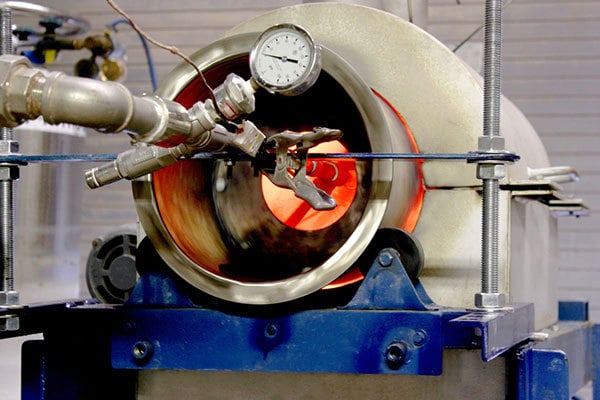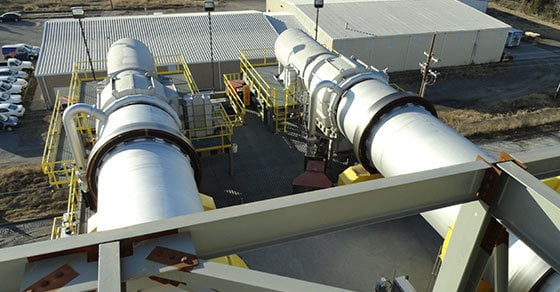Rotary kilns (also known as rotary calciners) are used to heat solids to a predetermined temperature in a controlled processing environment in order to create a chemical and/or physical reaction.
While rotary kilns have long been used in producing cement, their flexible capabilities have extended their use to a number of other applications; the two basic types of rotary kilns – direct fired and indirect fired – can be found supporting processes throughout nearly every industry, some of the most common of which are reviewed here.
Common Applications for Rotary Kilns
Metal Recovery
Rotary kilns have become essential in facilitating metal recovery from wastes, particularly in recent years as the pressure to create a circular economy has continued to rise.
Whether processing tailings, e-waste, or even industrial by-products, the diverse capabilities of rotary kilns offer the ideal opportunity to control the processing environment as needed to target and recover metals from various waste sources. Additional specific wastes often processed for metal recovery in rotary kilns include:
- Red mud (Bauxite residue/tailings)
- Spent catalysts
- Spent batteries
- Circuit boards
Catalyst Production & Recovery
The role of catalysts in industry has continued to grow in the pursuit of more efficient and advancing technologies. As part of catalyst preparation, rotary kilns have become the tool of choice for carrying out the calcination process, which plays a critical role in bonding the catalyst metal to the chosen carrier.
In addition, the role of rotary kilns in sustainably managing spent catalysts has also been growing. Through their employment of a controlled processing atmosphere and high temperatures, rotary kilns can not only be used to recover metals from spent catalysts, but also to regenerate or reactivate spent catalysts for reuse.
Incineration
Growing volumes of waste, particularly in the face of the pandemic, has seen the use of the incineration technique rise in waste management efforts. The incineration process breaks down or decomposes materials into simple compounds, a technique vital for wastes that are not otherwise easily recycled or that contain toxic components.
In addition to reducing waste volume and eliminating hazardous components, incineration can also serve as a source of reusable waste heat to reduce energy requirements in the facility, or to recover energy for producing electricity. Rotary kilns are the preferred type of equipment for carrying out incineration, as they are capable of processing multiple types of waste streams simultaneously – a major advantage over other types of thermal processing equipment.
Plastics Pyrolysis
As with incineration, the use of pyrolysis in waste management efforts has also been growing, particularly when it comes to advanced plastics recycling.
The sustainable management of plastics has become a top priority as generations of plastic wastes continue to build up and cause harm to wildlife and the environment. The surge of single-use plastics that accompanied the pandemic has further intensified the pressure surrounding this movement.
Through pyrolysis in a rotary kiln, plastics can be broken down into their most basic building blocks, so they can be converted into a number of fuels and petroleum-based products such as fuel oils, lubricants, petrochemicals, and more. This technology is often referred to as plastics-to-fuel technology, or PTF.
This approach to managing plastic wastes provides a much-needed outlet for plastics that are not easily recycled through traditional mechanical avenues, and again, rotary kilns are the tool of choice.
Roofing Granule Production
Unbeknownst to many, rotary kilns play a vital role in roofing granule production, serving to cure the colored coating onto granules via chemically bonding the two materials together.
In this setting, rotary kilns not only provide the high-capacity throughput required by roofing granule plants, but they also offer a robust build capable of withstanding the demanding processing conditions required of the industry.
The temperature control capabilities afforded by the rotary kiln also help to ensure color consistency and stability in the end product. Further, proper curing ensures that the granules will serve their purpose in protecting the asphalt shingle from harmful UV rays and premature breakdown.
Calcining Spodumene for Lithium Recovery
As producers scramble to meet the surging demand for lithium, spodumene, a lithium-bearing ore, has made a comeback in the mining industry. The material had fallen out of favor decades ago, owing to the less costly and more simple extraction of lithium brines.
To extract lithium from spodumene, the material must be processed via calcination in order to convert the ore’s crystal structure from monoclinic alpha (a-form) to tetragonal beta (β-form). Calcination is then further employed in the acid roasting of spodumene, so that lithium can be extracted as water-soluble lithium sulfate.
With their heavy-duty design and construction, rotary kilns are ideal for the calcination of spodumene in the lithium extraction process.
Decoating (Delacquering) Aluminum
Decoating, or delacquering, is necessary in some aluminum recycling operations to remove any coatings, paints, oils, or lacquers that were applied to the product for its intended end use.
Through delacquering, aluminum recyclers can reduce the amount of metal loss they experience, make processing conditions safer, and accept a wider range of aluminum scrap.
Here again, rotary kilns are the preferred device for carrying out the decoating process.
Testing & Development for Rotary Kiln Applications
The design and operation of a rotary kiln are critical to its efficiency. If designed incorrectly, a rotary kiln will inadequately treat materials and drastically increase operating costs. For this reason, FEECO recommends conducting batch- and pilot-scale test work in The FEECO Innovation Center.
Testing allows customers to gain a familiarity with their material and its response to thermal treatment, as well as optimize their process for performance and efficiency. The Innovation Center features several batch- and pilot-scale direct and indirect kilns for carrying out thermal treatment tests in each stage of process development and optimization.

Batch indirect-fired rotary kiln used for testing in the FEECO Innovation Center
Conclusion
The diverse capabilities of rotary kilns make them the preferred thermal processing equipment in a wide array of settings, from recovering metal from wastes, to calcining spodumene for lithium recovery.
FEECO is the leading provider of custom rotary kilns, developing all rotary kilns around the characteristics of the specific feedstock source and process goals. With testing and development services, as well as extensive parts and service support, FEECO is the industry leader in rotary kiln design and support. For more information on rotary kilns or thermal process testing, contact us today!



